tow FIAT DOBLO COMBI 2014 Owner handbook (in English)
[x] Cancel search | Manufacturer: FIAT, Model Year: 2014, Model line: DOBLO COMBI, Model: FIAT DOBLO COMBI 2014Pages: 283, PDF Size: 6.31 MB
Page 107 of 283
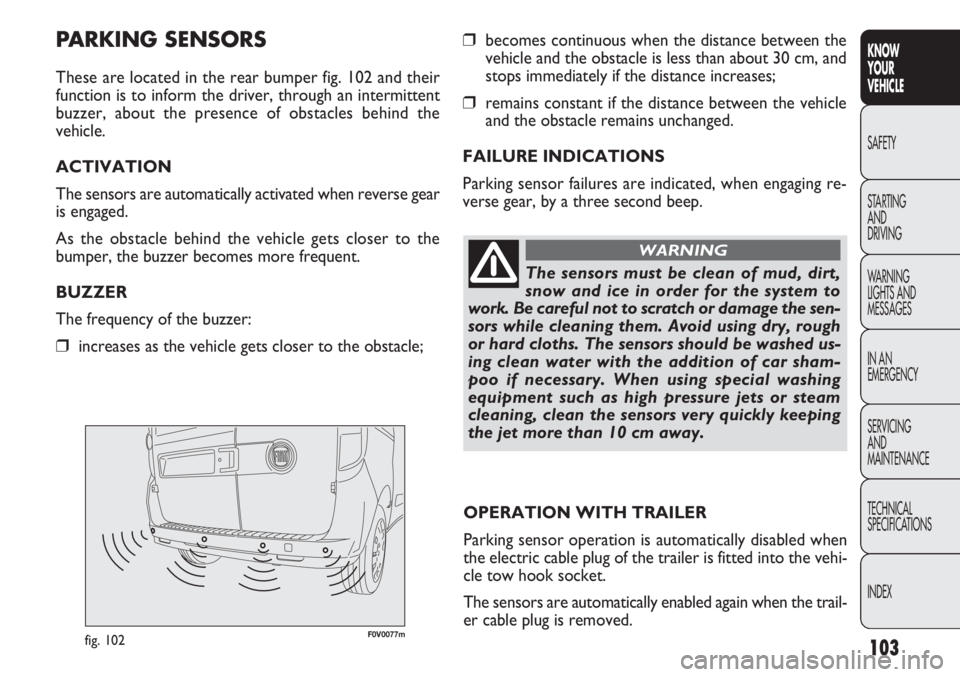
103
KNOW
YOUR
VEHICLE
SAFETY
STAR
TING
AND
DRIVING
WARNING
LIGHTS AND
MESSAGES
IN AN
EMERGENCY
SERVICING
AND
MAINTENANCE
TECHNICAL
SPECIFICATIONS
INDEX
F0V0077mfig. 102
❒becomes continuous when the distance between the
vehicle and the obstacle is less than about 30 cm, and
stops immediately if the distance increases;
❒remains constant if the distance between the vehicle
and the obstacle remains unchanged.
FAILURE INDICATIONS
Parking sensor failures are indicated, when engaging re-
verse gear, by a three second beep.
PARKING SENSORS
These are located in the rear bumper fig. 102 and their
function is to inform the driver, through an intermittent
buzzer, about the presence of obstacles behind the
vehicle.
ACTIVATION
The sensors are automatically activated when reverse gear
is engaged.
As the obstacle behind the vehicle gets closer to the
bumper, the buzzer becomes more frequent.
BUZZER
The frequency of the buzzer:
❒increases as the vehicle gets closer to the obstacle;
OPERATION WITH TRAILER
Parking sensor operation is automatically disabled when
the electric cable plug of the trailer is fitted into the vehi-
cle tow hook socket.
The sensors are automatically enabled again when the trail-
er cable plug is removed.
The sensors must be clean of mud, dirt,
snow and ice in order for the system to
work. Be careful not to scratch or damage the sen-
sors while cleaning them. Avoid using dry, rough
or hard cloths. The sensors should be washed us-
ing clean water with the addition of car sham-
poo if necessary. When using special washing
equipment such as high pressure jets or steam
cleaning, clean the sensors very quickly keeping
the jet more than 10 cm away.
WARNING
Page 113 of 283
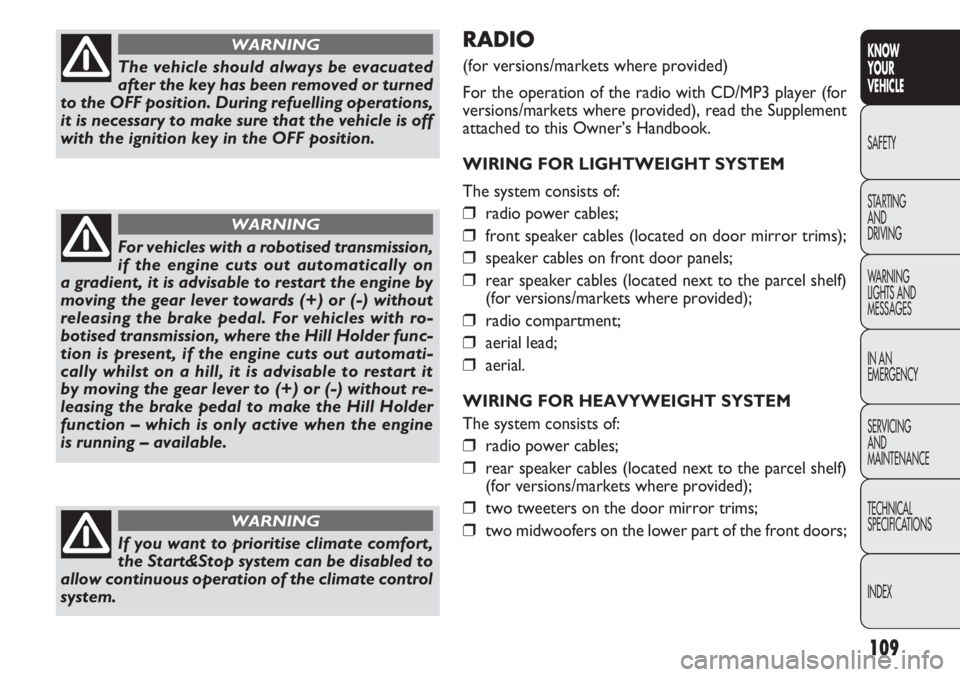
109
KNOW
YOUR
VEHICLE
SAFETY
STAR
TING
AND
DRIVING
WARNING
LIGHTS AND
MESSAGES
IN AN
EMERGENCY
SERVICING
AND
MAINTENANCE
TECHNICAL
SPECIFICATIONS
INDEX
RADIO
(for versions/markets where provided)
For the operation of the radio with CD/MP3 player (for
versions/markets where provided), read the Supplement
attached to this Owner’s Handbook.
WIRING FOR LIGHTWEIGHT SYSTEM
The system consists of:
❒radio power cables;
❒front speaker cables (located on door mirror trims);
❒speaker cables on front door panels;
❒rear speaker cables (located next to the parcel shelf)
(for versions/markets where provided);
❒radio compartment;
❒aerial lead;
❒aerial.
WIRING FOR HEAVYWEIGHT SYSTEM
The system consists of:
❒radio power cables;
❒rear speaker cables (located next to the parcel shelf)
(for versions/markets where provided);
❒two tweeters on the door mirror trims;
❒two midwoofers on the lower part of the front doors;
The vehicle should always be evacuated
after the key has been removed or turned
to the OFF position. During refuelling operations,
it is necessary to make sure that the vehicle is off
with the ignition key in the OFF position.
WARNING
For vehicles with a robotised transmission,
if the engine cuts out automatically on
a gradient, it is advisable to restart the engine by
moving the gear lever towards (+) or (-) without
releasing the brake pedal. For vehicles with ro-
botised transmission, where the Hill Holder func-
tion is present, if the engine cuts out automati-
cally whilst on a hill, it is advisable to restart it
by moving the gear lever to (+) or (-) without re-
leasing the brake pedal to make the Hill Holder
function – which is only active when the engine
is running – available.
WARNING
If you want to prioritise climate comfort,
the Start&Stop system can be disabled to
allow continuous operation of the climate control
system.
WARNING
Page 139 of 283
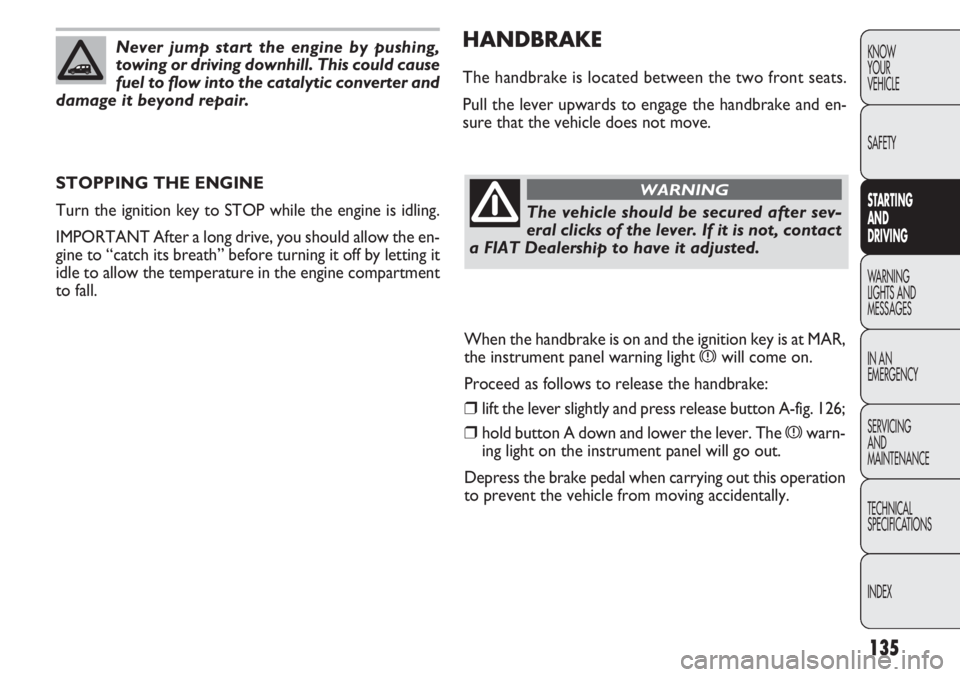
135
KNOW
YOUR
VEHICLE
SAFETY
STARTING
AN
D
DRIVING
WARNING
LIGHTS AND
MESSAGES
IN AN
EMERGENCY
SERVICING
AND
MAINTENANCE
TECHNICAL
SPECIFICA TIONS
INDEX
HANDBRAKE
The handbrake is located between the two front seats.
Pull the lever upwards to engage the handbrake and en-
sure that the vehicle does not move.
STOPPING THE ENGINE
Turn the ignition key to STOP while the engine is idling.
IMPORTANT After a long drive, you should allow the en-
gine to “catch its breath” before turning it off by letting it
idle to allow the temperature in the engine compartment
to fall.
Never jump start the engine by pushing,
towing or driving downhill. This could cause
fuel to flow into the catalytic converter and
damage it beyond repair.
The vehicle should be secured after sev-
eral clicks of the lever. If it is not, contact
a FIAT Dealership to have it adjusted.
WARNING
When the handbrake is on and the ignition key is at MAR,
the instrument panel warning light
xwill come on.
Proceed as follows to release the handbrake:
❒lift the lever slightly and press release button A-fig. 126;
❒hold button A down and lower the lever. The xwarn-
ing light on the instrument panel will go out.
Depress the brake pedal when carrying out this operation
to prevent the vehicle from moving accidentally.
Page 141 of 283
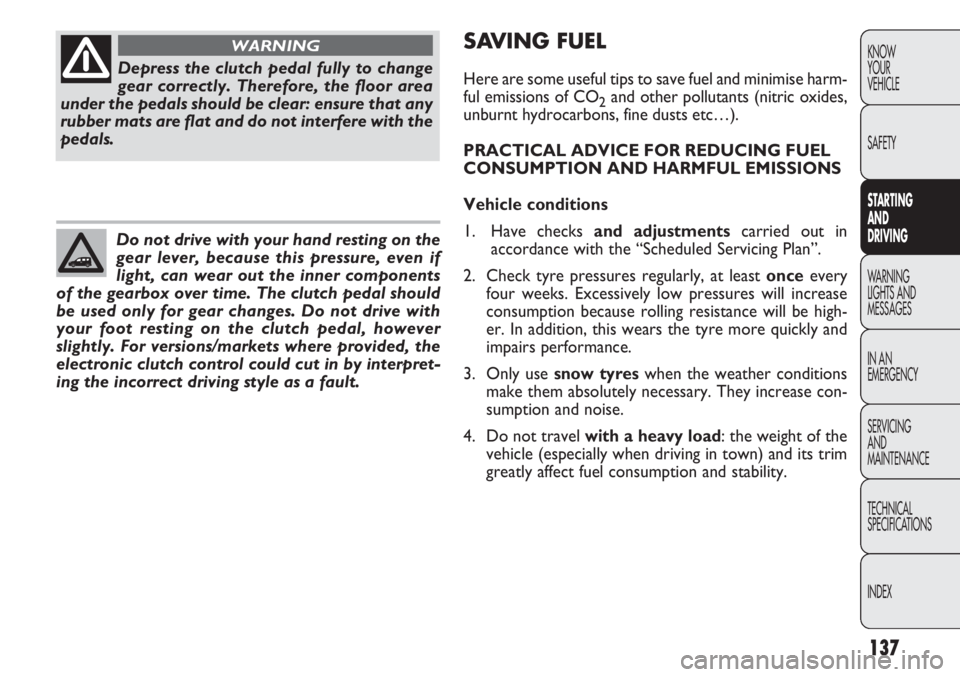
137
KNOW
YOUR
VEHICLE
SAFETY
STARTING
AN
D
DRIVING
WARNING
LIGHTS AND
MESSAGES
IN AN
EMERGENCY
SERVICING
AND
MAINTENANCE
TECHNICAL
SPECIFICA TIONS
INDEX
Depress the clutch pedal fully to change
gear correctly. Therefore, the floor area
under the pedals should be clear: ensure that any
rubber mats are flat and do not interfere with the
pedals.
WARNING
Do not drive with your hand resting on the
gear lever, because this pressure, even if
light, can wear out the inner components
of the gearbox over time. The clutch pedal should
be used only for gear changes. Do not drive with
your foot resting on the clutch pedal, however
slightly. For versions/markets where provided, the
electronic clutch control could cut in by interpret-
ing the incorrect driving style as a fault.
SAVING FUEL
Here are some useful tips to save fuel and minimise harm-
ful emissions of CO
2and other pollutants (nitric oxides,
unburnt hydrocarbons, fine dusts etc…).
PRACTICAL ADVICE FOR REDUCING FUEL
CONSUMPTION AND HARMFUL EMISSIONS
Vehicle conditions
1. Have checks and adjustments carried out in
accordance with the “Scheduled Servicing Plan”.
2. Check tyre pressures regularly, at least once every
four weeks. Excessively low pressures will increase
consumption because rolling resistance will be high-
er. In addition, this wears the tyre more quickly and
impairs performance.
3. Only use snow tyres when the weather conditions
make them absolutely necessary. They increase con-
sumption and noise.
4. Do not travel with a heavy load: the weight of the vehicle (especially when driving in town) and its trim
greatly affect fuel consumption and stability.
Page 143 of 283
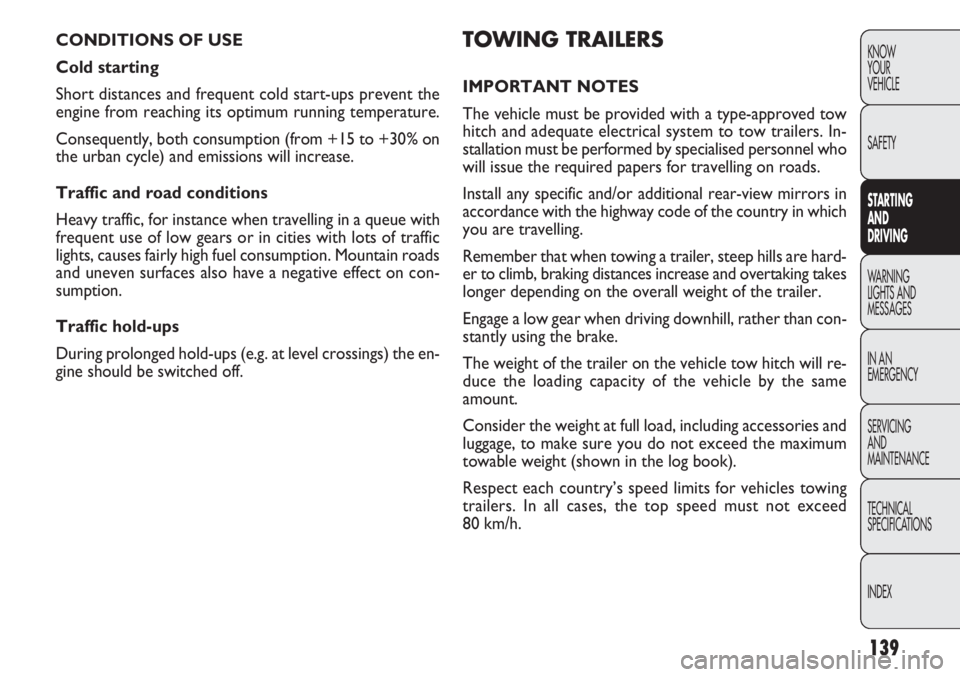
139
KNOW
YOUR
VEHICLE
SAFETY
STARTING
AN
D
DRIVING
WARNING
LIGHTS AND
MESSAGES
IN AN
EMERGENCY
SERVICING
AND
MAINTENANCE
TECHNICAL
SPECIFICA TIONS
INDEX
TOWING TRAILERS
IMPORTANT NOTES
The vehicle must be provided with a type-approved tow
hitch and adequate electrical system to tow trailers. In-
stallation must be performed by specialised personnel who
will issue the required papers for travelling on roads.
Install any specific and/or additional rear-view mirrors in
accordance with the highway code of the country in which
you are travelling.
Remember that when towing a trailer, steep hills are hard-
er to climb, braking distances increase and overtaking takes
longer depending on the overall weight of the trailer.
Engage a low gear when driving downhill, rather than con-
stantly using the brake.
The weight of the trailer on the vehicle tow hitch will re-
duce the loading capacity of the vehicle by the same
amount.
Consider the weight at full load, including accessories and
luggage, to make sure you do not exceed the maximum
towable weight (shown in the log book).
Respect each country’s speed limits for vehicles towing
trailers. In all cases, the top speed must not exceed
80 km/h.
CONDITIONS OF USE
Cold starting
Short distances and frequent cold start-ups prevent the
engine from reaching its optimum running temperature.
Consequently, both consumption (from +15 to +30% on
the urban cycle) and emissions will increase.
Traffic and road conditions
Heavy traffic, for instance when travelling in a queue with
frequent use of low gears or in cities with lots of traffic
lights, causes fairly high fuel consumption. Mountain roads
and uneven surfaces also have a negative effect on con-
sumption.
Traffic hold-ups
During prolonged hold-ups (e.g. at level crossings) the en-
gine should be switched off.
Page 149 of 283
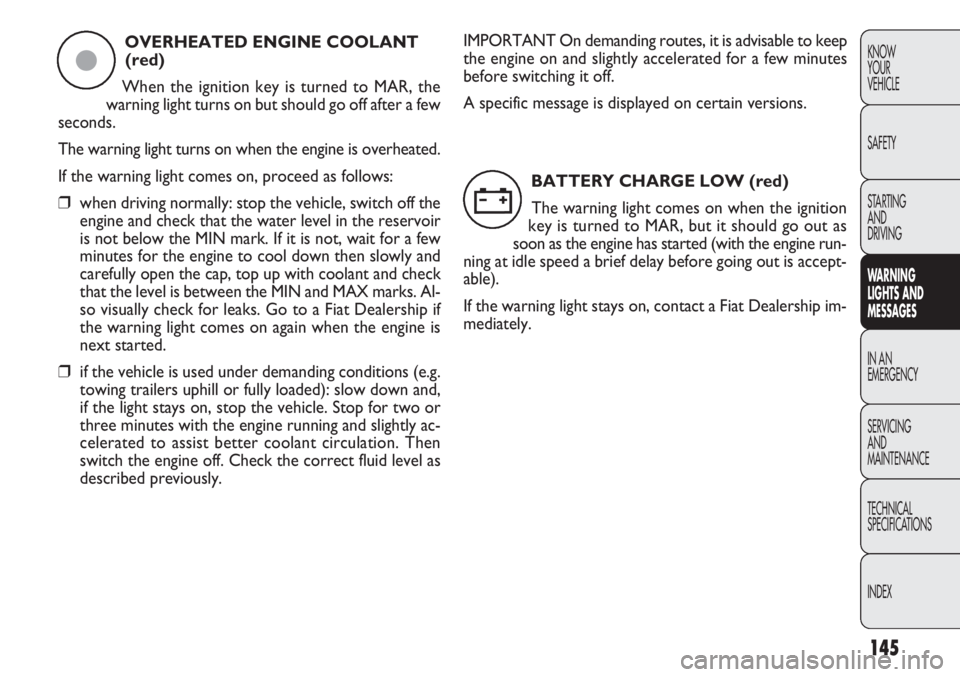
145
KNOW
YOUR
VEHICLE
SAFETY
STARTING
AND
DRIVING
WA R N I NG
LIGHTS AND
MESSAGES
IN AN
EMERGENCY
SERVICING
AND
MAINTENANCE
TECHNICAL
SPECIFICA TIONS
INDEXOVERHEATED ENGINE COOLANT (red)
When the ignition key is turned to MAR, the
warning light turns on but should go off after a few
seconds.
The warning light turns on when the engine is overheated.
If the warning light comes on, proceed as follows:
❒ when driving normally: stop the vehicle, switch off the
engine and check that the water level in the reservoir
is not below the MIN mark. If it is not, wait for a few
minutes for the engine to cool down then slowly and
carefully open the cap, top up with coolant and check
that the level is between the MIN and MAX marks. Al-
so visually check for leaks. Go to a Fiat Dealership if
the warning light comes on again when the engine is
next started.
❒ if the vehicle is used under demanding conditions (e.g.
towing trailers uphill or fully loaded): slow down and,
if the light stays on, stop the vehicle. Stop for two or
three minutes with the engine running and slightly ac-
celerated to assist better coolant circulation. Then
switch the engine off. Check the correct fluid level as
described previously.
ç
IMPORTANT On demanding routes, it is advisable to keep
the engine on and slightly accelerated for a few minutes
before switching it off.
A specific message is displayed on certain versions.
BATTERY CHARGE LOW (red)The warning light comes on when the ignition
key is turned to MAR, but it should go out as
soon as the engine has started (with the engine run-
ning at idle speed a brief delay before going out is accept-
able).
If the warning light stays on, contact a Fiat Dealership im-
mediately.
w
Page 151 of 283
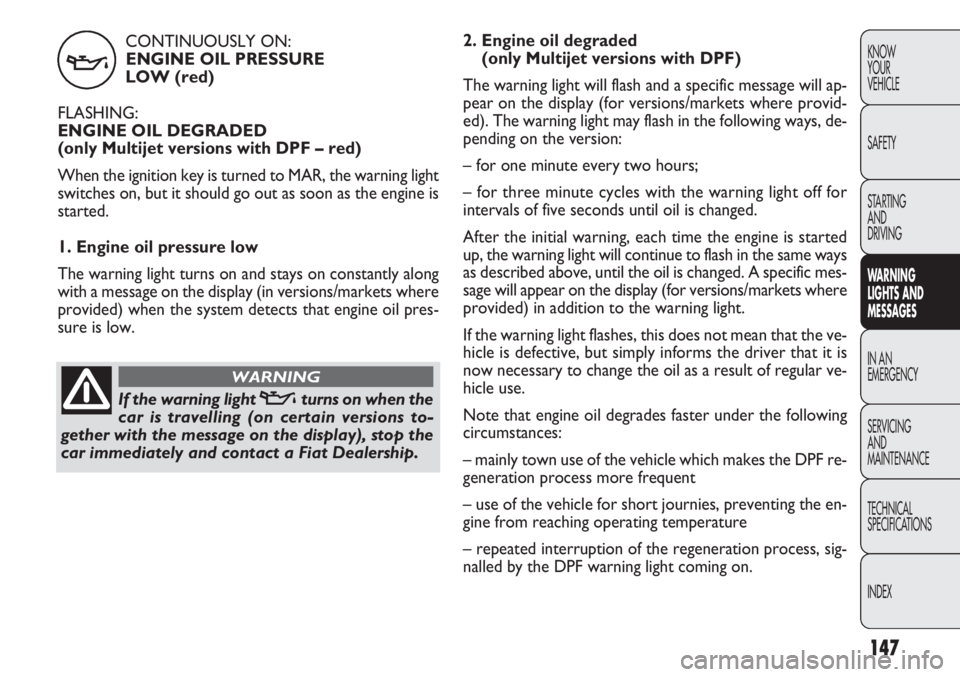
CONTINUOUSLY ON:ENGINE OIL PRESSURE
LOW (red)
FLASHING:
ENGINE OIL DEGRADED
(only Multijet versions with DPF – red)
When the ignition key is turned to MAR, the warning light
switches on, but it should go out as soon as the engine is
started.
1. Engine oil pressure low
The warning light turns on and stays on constantly along
with a message on the display (in versions/markets where
provided) when the system detects that engine oil pres-
sure is low.
147
KNOW
YOUR
VEHICLE
SAFETY
STARTING
AND
DRIVING
WA R N I N G
LIGHTS AND
MESSAGES
IN AN
EMERGENCY
SERVICING
AND
MAINTENANCE
TECHNICAL
SPECIFICA TIONS
INDEXv
If the warning light vturns on when the
car is travelling (on certain versions to-
gether with the message on the display), stop the
car immediately and contact a Fiat Dealership.
WARNING
2. Engine oil degraded (only Multijet versions with DPF)
The warning light will flash and a specific message will ap-
pear on the display (for versions/markets where provid-
ed). The warning light may flash in the following ways, de-
pending on the version:
– for one minute every two hours;
– for three minute cycles with the warning light off for
intervals of five seconds until oil is changed.
After the initial warning, each time the engine is started
up, the warning light will continue to flash in the same ways
as described above, until the oil is changed. A specific mes-
sage will appear on the display (for versions/markets where
provided) in addition to the warning light.
If the warning light flashes, this does not mean that the ve-
hicle is defective, but simply informs the driver that it is
now necessary to change the oil as a result of regular ve-
hicle use.
Note that engine oil degrades faster under the following
circumstances:
– mainly town use of the vehicle which makes the DPF re-
generation process more frequent
– use of the vehicle for short journies, preventing the en-
gine from reaching operating temperature
– repeated interruption of the regeneration process, sig-
nalled by the DPF warning light coming on.
Page 160 of 283
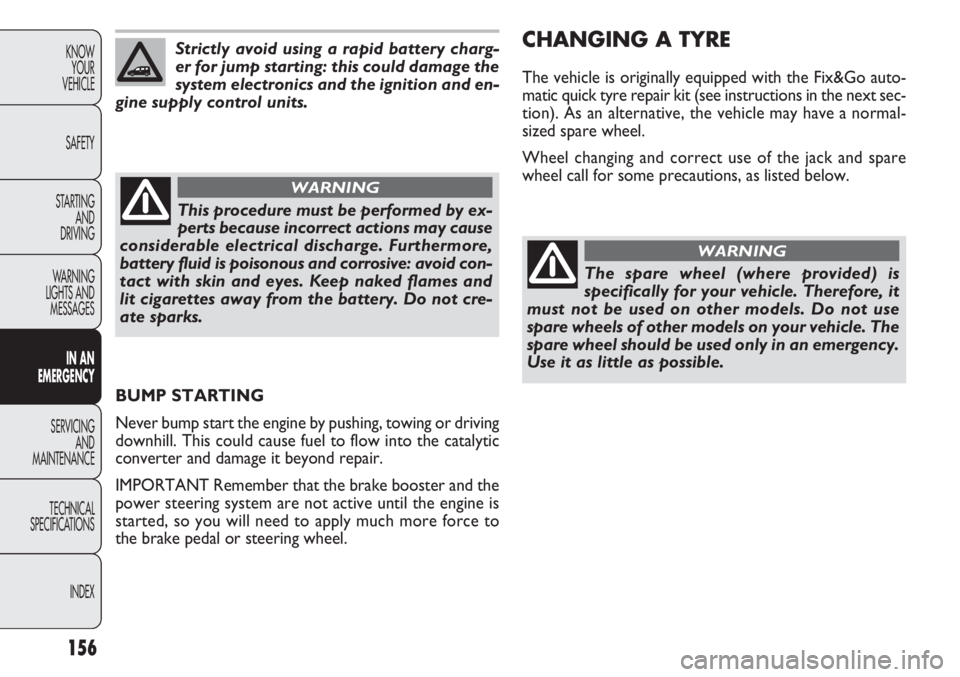
156
KNOWYOUR
VEHICLE
SAFETY
STARTING AND
DRIVING
WARNING
LIGHTS AND MESSAGES
IN AN
EMERGENCY
SERVICING AND
MAINTENANCE
TECHNICAL
SPECIFICA TIONS
INDEXStrictly avoid using a rapid battery charg-
er for jump starting: this could damage the
system electronics and the ignition and en-
gine supply control units.
This procedure must be performed by ex-
perts because incorrect actions may cause
considerable electrical discharge. Furthermore,
battery fluid is poisonous and corrosive: avoid con-
tact with skin and eyes. Keep naked flames and
lit cigarettes away from the battery. Do not cre-
ate sparks.
WARNING
BUMP STARTING
Never bump start the engine by pushing, towing or driving
downhill. This could cause fuel to flow into the catalytic
converter and damage it beyond repair.
IMPORTANT Remember that the brake booster and the
power steering system are not active until the engine is
started, so you will need to apply much more force to
the brake pedal or steering wheel.
CHANGING A TYRE
The vehicle is originally equipped with the Fix&Go auto-
matic quick tyre repair kit (see instructions in the next sec-
tion). As an alternative, the vehicle may have a normal-
sized spare wheel.
Wheel changing and correct use of the jack and spare
wheel call for some precautions, as listed below.
The spare wheel (where provided) is
specifically for your vehicle. Therefore, it
must not be used on other models. Do not use
spare wheels of other models on your vehicle. The
spare wheel should be used only in an emergency.
Use it as little as possible.
WARNING
Page 193 of 283
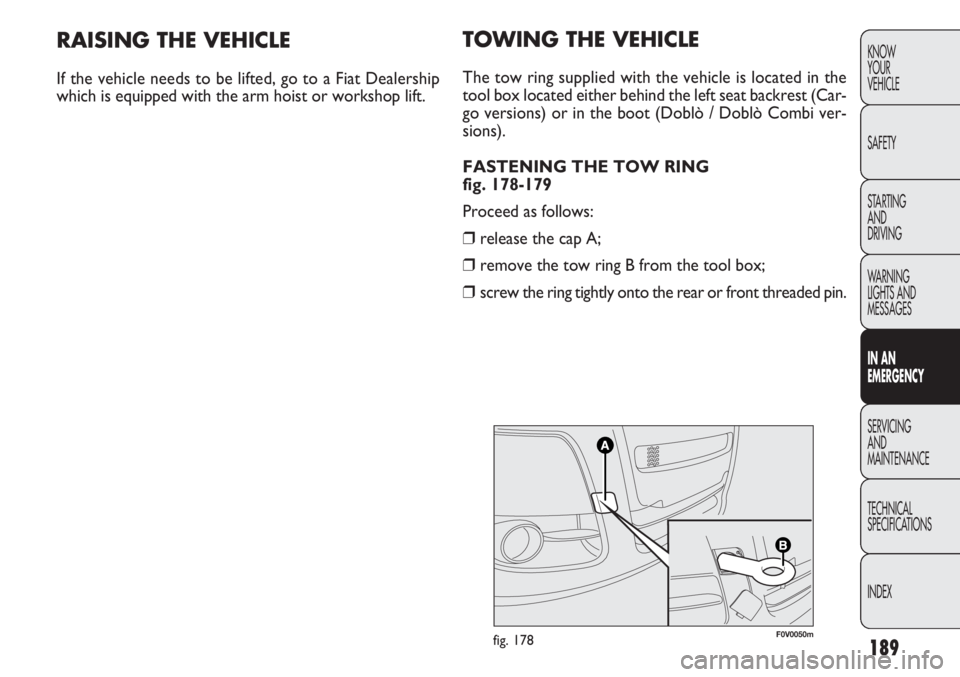
189
KNOW
YOUR
VEHICLE
SAFETY
STARTING
AND
DRIVING
WARNING
LIGHTS AND
MESSAGES
IN AN
EMERGENCY
SERVICING
AND
MAINTENANCE
TECHNICAL
SPECIFICATIONS
INDEXTOWING THE VEHICLE
The tow ring supplied with the vehicle is located in the
tool box located either behind the left seat backrest (Car-
go versions) or in the boot (Doblò / Doblò Combi ver-
sions).
FASTENING THE TOW RING
fig. 178-179
Proceed as follows:
❒ release the cap A;
❒ remove the tow ring B from the tool box;
❒ screw the ring tightly onto the rear or front threaded pin.
F0V0050mfig. 178
RAISING THE VEHICLE
If the vehicle needs to be lifted, go to a Fiat Dealership
which is equipped with the arm hoist or workshop lift.
Page 194 of 283
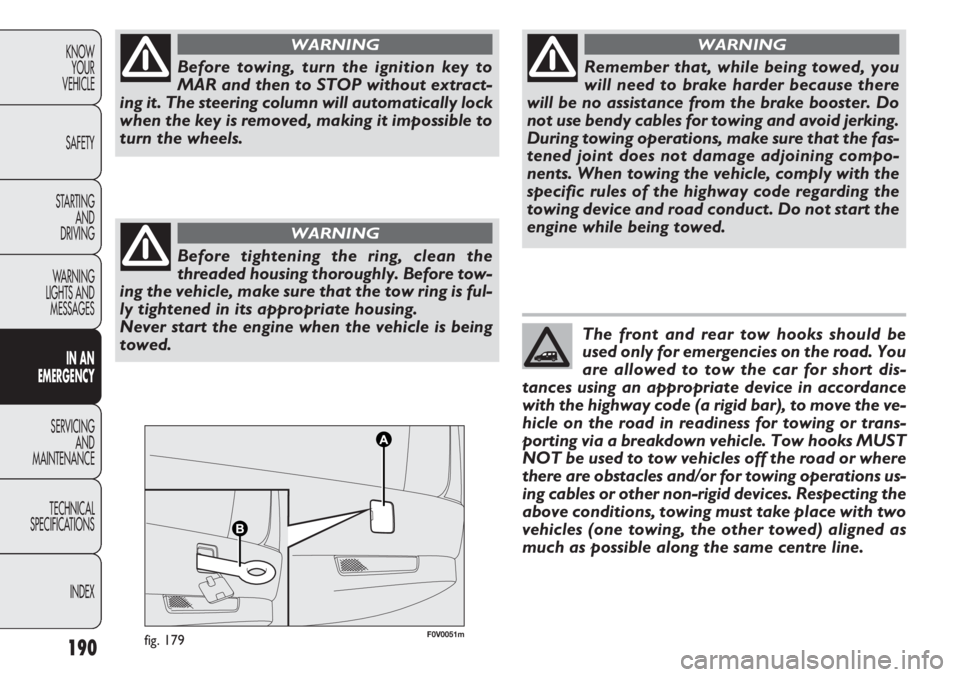
190
KNOWYOUR
VEHICLE
SAFETY
STARTING AND
DRIVING
WARNING
LIGHTS AND MESSAGES
IN AN
EMERGENCY
SERVICING AND
MAINTENANCE
TECHNICAL
SPECIFICA TIONS
INDEX
F0V0051mfig. 179
Before towing, turn the ignition key to
MAR and then to STOP without extract-
ing it. The steering column will automatically lock
when the key is removed, making it impossible to
turn the wheels.
WARNING
Before tightening the ring, clean the
threaded housing thoroughly. Before tow-
ing the vehicle, make sure that the tow ring is ful-
ly tightened in its appropriate housing.
Never start the engine when the vehicle is being
towed.
WARNING
Remember that, while being towed, you
will need to brake harder because there
will be no assistance from the brake booster. Do
not use bendy cables for towing and avoid jerking.
During towing operations, make sure that the fas-
tened joint does not damage adjoining compo-
nents. When towing the vehicle, comply with the
specific rules of the highway code regarding the
towing device and road conduct. Do not start the
engine while being towed.
WARNING
The front and rear tow hooks should be
used only for emergencies on the road. You
are allowed to tow the car for short dis-
tances using an appropriate device in accordance
with the highway code (a rigid bar), to move the ve-
hicle on the road in readiness for towing or trans-
porting via a breakdown vehicle. Tow hooks MUST
NOT be used to tow vehicles off the road or where
there are obstacles and/or for towing operations us-
ing cables or other non-rigid devices. Respecting the
above conditions, towing must take place with two
vehicles (one towing, the other towed) aligned as
much as possible along the same centre line.